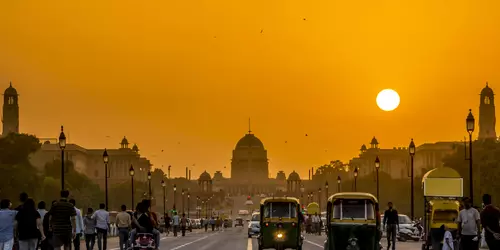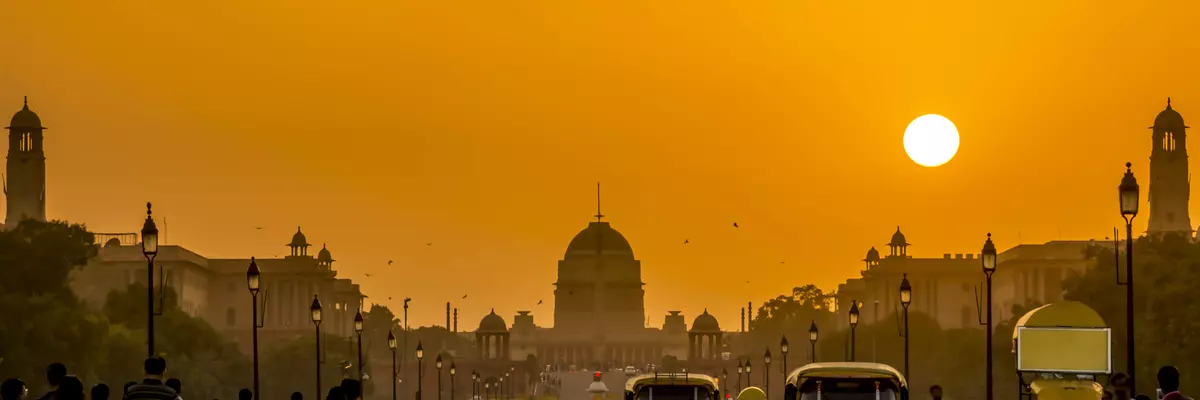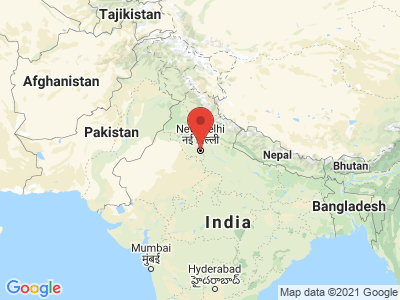Climate Table New Delhi
Jan | Feb | Mar | Apr | May | Jun | Jul | Aug | Sep | Oct | Nov | Dec | |
|---|---|---|---|---|---|---|---|---|---|---|---|---|
| Max. Temperature | 21° | 24° | 29° | 36° | 41° | 39° | 35° | 34° | 34° | 34° | 28° | 23° |
| Min. Temperature | 6° | 10° | 14° | 20° | 26° | 28° | 27° | 26° | 24° | 17° | 11° | 7° |
| Sun Hours | 8 | 8 | 8 | 9 | 9 | 8 | 6 | 6 | 7 | 9 | 9 | 8 |
| Rain Days | 1 | 2 | 2 | 1 | 2 | 6 | 11 | 11 | 6 | 0 | 0 | 1 |
The climate year of New Delhi
New Delhi is part of the Delhi metropolitan area, one of the most populous metropolitan areas in the world with over 20 million inhabitants. The region is located in the interior of the country 200 km southwest of the Himalayas and about 1000 km from the nearest coast. The climate is characterized by many hours of sunshine throughout the year and three to four months of rain in the summer, as well as many dry months. The metropolitan area combines modern, historical and religious aspects. New Delhi is the seat of government of India. Geographically, New Delhi is located in the central north of India and has a subtropical (steppe) climate. This is characterized by hot summers and cool but mild winters. Due to the heat, only a certain vegetation is possible. Except for the time of the monsoon in summer, it is dry.
General information about New Delhi
In New Delhi, first of all, the buildings of the late colonial period, which already seems modern, can be admired. The modernity reflects a facet of the diverse and historically rich India. The British developed the present seat of government, New Delhi, as a new district of Delhi. Many high-rise buildings characterize the scenery.
The Jantar Mantar public observatory was built in the open air in the early 18th century, and the large sundials are an attraction.
The Agrasen Ki Baoli stepped fountain is one of the oldest evidence of settlement there and provides a historical anchor point of the 14th century history. Externally, the fountain looks picturesque with its moss-covered vaults. During the rainy seasons, the monsoon fills the well with water.
The central axis of New Delhi is the royal promenade Rajpath. On it is the India Gate, modeled after the Arc de Triomphe in Paris. Even though New Delhi is only a part of Delhi, a city of over a million people, it is possible to visit a number of noteworthy features and trace a bit of India's diverse and complex history over a few centuries. Above all, however, New Delhi is a landmark of the country's British colonial history. Nevertheless, the city outside of this part should of course also be visited to discover the diversity of India.
Tourism New Delhi
The climatic conditions of Delhi are also characterized by the so-called steppe climate. This in itself belongs to the dry climates, as well as the desert climate is one. Over the year, the temperatures are very warm for European conditions. Due to fluctuations in humidity, the climate varies between dry and humid, depending on the seasons. The rainy season lasts from the end of June to the beginning of September. The monsoon is responsible for over 90% of the total annual precipitation. During this rainy period, the climate can appear subtropical. The rest of the rain is evenly distributed over the months of October to May inclusive. In this period it is dry, as it is characteristic for the steppe climate. The annual climate can be basically explained in three different cycles. The maximum temperature is reached in May, the maximum precipitation in July and the maximum humidity in August. Frost is theoretically possible in December and January but extremely rare. Throughout the year, regardless of rainfall or drought, there are many hours of sunshine per day in New Delhi, most in March and May. Within New Delhi and Delhi respectively, there is little microclimatic variation. This is due to New Delhi s location in the interior of India.


